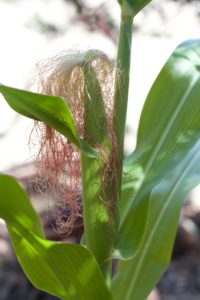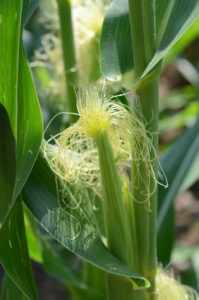Types of Corn
Corn was originally cultivated in the Americas but was brought back to Europe for cultivation back in the 1500s. It is a grain crop used to create corn starches, cereals, sugar extracts, and eaten whole! There are many different varieties of corn that all have different sugar levels affecting the sweetness. The three most common varieties of sweet corn are the sugary-1, shrunken-2, and sugary enhanced. The sugary-1 kernels are sweet and starchy. Shrunken-2 are by far the sweetest variety, sometimes called “super sweets.” Despite the name, sugary enhanced corn is not as sweet as shrunken-2. These corns are the ones typically found in grocery stores or roasted at a BBQ. Sweet corn is high in fiber, as well as B vitamins, magnesium, vitamin E & K, and potassium.
Popcorn is a type of flint corn. At full maturity, the kernels will be rock-hard. Popcorn is a light and healthy snack that is extremely low in calories. Waxy corn is mainly grown for its super high starch content. Waxy is mainly used as a food additive or to make adhesives. Few people have eaten dent corn, but it is the most grown corn in the USA. Dent corn is used to feed livestock or is reduced into a sweetener. It is also the grain used to produce ethanol – the gasoline additive.
How to Plant Corn

Corn, aka maize, is an annual that requires full sun exposure to grow and can be grown in growing zones 3-11. Unlike most vegetables, corn grows best in more acidic soil 5.8 – 6.2 pH. Be careful to make sure your soil isn’t too acidic though. A soil lower than 5.5 pH can stunt or prevent the growth of your corn stalks. Soil should be fertile and sandy or loamy, but well drained. Corn does not grow well from transplants, so it is recommended you start from seed directly in the ground, or in containers. Some corn can be purchased in biodegradable containers that you can place directly into the ground. Corn is extremely sensitive to soil temperature and frost, make sure soil temperatures reach at least 60 degrees and the frost has passed.
While planting outside, dig holes 1 inch deep and 6 inches apart. Once the corn reaches 5-8 inches in height, thin the rows until each corn stalk is 12 inches apart. Corn should be planted in large rows with ample space between them to walk between. Corn rows should be approximately 3 feet apart. Corn should always be planted in large rows or blocks as corn needs pollination to grow properly. As the wind blows, it will blow pollen back and forth between the corn plants.
When planting in containers, corn requires a large 12-inch-deep container. Water your corn plants regularly, keeping the soil moist. As previously mentioned, make sure you cluster multiple corn containers near each other for pollination purposes. Applying a 10-10-10 npk fertilizer every few weeks is also recommended. You can also use fish emulsion or a commercial grade fertilizer. Always test your soil for nutrients before applying fertilizer.
How to Harvest Corn
Once the corn stalks reach maturity, the ears will develop corn silk at the tip. Depending on the climate, corn should be ready to harvest 14-25 days after you see the corns silk appearing. If your stalk has two or more ears of corn, the upper ears will mature a few days before the lower ears. Once the silk has browned, open one corn husk and check for maturity. Each kernel should be round and flat. If the kernels are small or pointy, they will need a few more days to mature. Corn is also very easy to store in the freezer. Simply remove the husks and save for later!

Corn Pests and Diseases

Anthracnose is a type of fungus that will leave yellow, brown, or black spots on the stems and leaves of your corn plant. A gelatinous growth will slowly develop that will cause the corn to rot. As with most fungus, excess moisture will cause fungus growth, so it is recommended you avoid above plant watering. If you detect early signs of anthracnose, apply a copper-based fungicide and neem oil.
Corn earworms will climb your corn stalks and eat the corn silks and kernels. Using insecticidal soaps or planting native plants that invite beneficial predatory insects should help.
Cucumber beetles will cause the corn to decay by spreading bacterial wilt. They will also eat and leave holes in the corn husks. Invite beneficial predatory insects to eat the beetles. Unfortunately, you will need to dispose of the corn plant if it becomes infected with bacterial wilt.
Deer and raccoons will eat the stalks or the entire corn ears. Spray coyote urine or blood meal around your corn plants. Fencing off your corn can help if the fence is at least 7 to 8 feet high. Shorter electrified fences can also be used as a deterrent if you have more issues with raccoons than deer.
Downy mildew will leave a yellow cottony fungus on the leaves or kernels of your corn plants. Applying a copper-based fungicide or neem oil should help get this fungus under control.
Planning Corn for Your Garden
Growing corn in your garden is a fun way to harvest fresh BBQ friendly vegetables at home. If you’re unsure how to plan for corn in your garden, try our garden planner Hortisketch. With Hortisketch you can plan your corn rows, then build a fence around it to protect it from deer. Plan out your irrigation system as well with sprinkler icons. Start planning your entire garden today!











